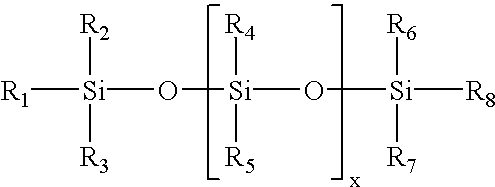Copolymerization of reactive silicone and urethane precursors for use in conductive, soft urethane rollers
a technology of reactive silicone and reactive urethane, which is applied in the direction of portable power-driven tools, instruments, and discharge of corona, can solve the problems of high cost, low production, and difficulty in coating a charge roller of high conductivity and soft durometer with one layer of rubber/foam (specifically urethane), and achieves low tackiness. the effect of good resistance to chang
- Summary
- Abstract
- Description
- Claims
- Application Information
AI Technical Summary
Benefits of technology
Problems solved by technology
Method used
Image
Examples
examples 2-8
[0046] Charge rollers described in the following examples were prepared using the same general procedure used in Example 1. The following tables provide the amount (in parts) of each ingredient in the thermoset copolymer:
3 Stream Ex. 2 Ex. 3 Ex. 4 Ex. 5 Ex. 6 Ex. 7 Ex. 8 B1 100.0 100.0 100.0 100.0 100.0 100.0 100.0 (I-2143L) A 437.3 396.7 548.6 419.2 480.5 477.1 475.3 Conductive curative B2 400.0 -- -- 503.5 312.0 312.0 312.0 (GP-145 / HP-6500T) B2 -- 334.3 322.4 -- ---- --(GP-145 / P-380)
[0047] Listed below is the composition of conductive curative (stream A) in each of Examples 2-8:
4 Composition Ex. 2 Ex. 3 Ex. 4 Ex. 5 Ex. 6 Ex. 7 Ex. 8 HP-6500T 325.9 -- -- 350.0 325.9 325.9 325.9 P-380 -- 250.0 450.0 -- -- -- --Poly BD 24.0 24.0 24.0 24.0 24.0 24.0 24.0 (20LM) TIPA 1.5 1.5 1.5 1.5 1.5 1.5 1.5 XB 11.5 11.5 11.5 11.5 11.5 11.5 11.5 Lithium 1.0 5.4 7.4 8.5 10.0 13.0 14.0 perchlorate (anhy.) Iron (III) -- -- -- ---- -- 9 chloride T-328 12.0 12.0 12.0 12.0 12.0 12.0 12.0 BHT 3.5 3.5 3.5 3...
examples 9-14
[0050] Developer rollers described in the following examples were prepared using the same general procedure used in Example 1. The following tables provide the amount (in parts) of each ingredient in the thermo set copolymer:
7 Stream Temp. Ex. 9 Ex. 10 Ex. 11 Ex. 12 Ex. 13 Ex. 14 B1 180.degree. F. 100.0 100.0 100.0 100.0 100.0 100.0 (V-6020; NCO = 6.85) A 150.degree. F. 24.7 21.7 21.8 21.8 21.8 21.8 Conductive curative B2 90.degree. F. 165.6 172.2 173.0 173.0 173.0 173.0 (GP-145 / HP-6500T)
[0051] Listed below is the composition of conductive curative (stream A) in each of Examples 9-14:
8 Composition Ex. 9 Ex. 10 Ex. 11 Ex. 12 Ex. 13 Ex. 14 HP-6500T 250.0 200.0 200.0 200.0 200.0 200.0 T-1000 20.0 20.0 20.0 20.0 20.0 20.0 TIPA 20.0 20.0 20.0 20.0 20.0 20.0 I-93 80.0 80.0 80.0 80.0 80.0 80.0 Iron (III) 0.56 0.08 0.14 0.20 -- --chloride Copper (II) 0.07 0.01 0.02 --0.25 --chloride Lithium 0.07 0.01 0.02 -- -- 0.22 perchlorate (anhy.) T-328 6.0 6.0 6.0 6.0 6.0 6.0 BHT 3.0 3.0 3.0 3.0 3.0 3...
PUM
| Property | Measurement | Unit |
|---|---|---|
| temperature | aaaaa | aaaaa |
| humidity | aaaaa | aaaaa |
| temperature | aaaaa | aaaaa |
Abstract
Description
Claims
Application Information
 Login to View More
Login to View More - R&D Engineer
- R&D Manager
- IP Professional
- Industry Leading Data Capabilities
- Powerful AI technology
- Patent DNA Extraction
Browse by: Latest US Patents, China's latest patents, Technical Efficacy Thesaurus, Application Domain, Technology Topic, Popular Technical Reports.
© 2024 PatSnap. All rights reserved.Legal|Privacy policy|Modern Slavery Act Transparency Statement|Sitemap|About US| Contact US: help@patsnap.com










